Potato Rosemary Rolls with Olive Oil and Semolina are soft due to the mashed potatoes, and a little crispy on the outside due to the olive oil.
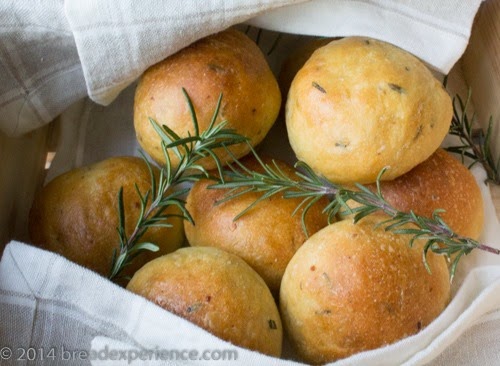
I attended a potluck luncheon on Super Bowl Sunday and my contribution was these potato rosemary and olive oil rolls. They were the perfect companion for the assortment of other foods that were served.
When I started thinking about what to bring, I knew I wanted to make rolls, I just wasn’t sure what kind. So I revisited one of my favorite breads for inspiration. Potato Rosemary Bread is one of the breads we made in the BBA Challenge. I liked that bread so I decided to try it again using a blend of flours.
These rolls are soft due to the mashed potatoes, but a little bit crispy on the outside due to the olive oil. And rosemary, well, I can never get enough of that herb. Fortunately, I just walk out the door and there it is ready to be enjoyed.
These rolls are easy to make and very flavorful. They were a big hit at the luncheon. I doubled the original recipe so I was able to make 32 rolls and I even had enough dough left over to make a medium loaf.
Potato Rosemary Rolls with Olive Oil & Semolina
Makes: 32 Rolls and 1 Medium Loaf
Adapted from: Bread Baker’s Apprentice method by Peter Reinhart
Biga:
- 2 1/2 cups unbleached all-purpose flour
- 1/2 teaspoon yeast
- 3/4 – 1 cup room temperature water
Making the overnight biga
Stir together the flour and yeast in a medium bowl. Add the water and stir until it becomes a coarse ball. Adjust the flour or water as necessary to ensure the dough is neither too sticky nor too stiff. Cover the bowl with plastic wrap and let it ferment at room temperature for 2 to 4 hours, or until it is almost double in size.
Remove the dough and knead it gently to just degas it a little bit. Then return the biga to the bowl, cover it with plastic wrap, and place it in the refrigerator overnight.
Final Dough:
- 1 cup semolina flour
- 2 cups unbleached all-purpose flour
- 3 cups unbleached bread flour
- 3 teaspoons sea salt
- 2 teaspoons yeast
- 1/2 teaspoon cracked black pepper
- 2 cups mashed potatoes, cooled
- 2 tablespoons olive oil
- 4 tablespoons coarsely chopped fresh rosemary
- 1 1/2 cups warm water
- all of the biga from above
- cornmeal or semolina for dusting
Mixing the Dough
The next day, remove the biga from the refrigerator 1 hour before you plan to make the bread and cut it into small pieces. Cover the pieces with plastic wrap or a kitchen towel and let them rest to take off the chill.
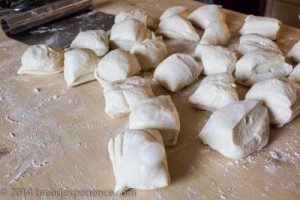
In the bowl of a stand mixer, stir together the flour, salt, black pepper, and yeast. Add the biga pieces, mashed potatoes, oil, rosemary, and water. Mix on 1st speed for 1 minute, or until the ingredients form a ball. Add more water or flour as necessary. Increase the speed to 2nd speed (or medium) and mix for about 6 minutes until the dough is soft and supple. It should be tacky but not sticky.
Proofing the Dough
Lightly oil a large bowl and transfer the dough to the bowl. Roll it around to coat it with oil. Cover the bowl with plastic wrap. Ferment the dough at room temperature for about 2 hours, or until the dough doubles in size.
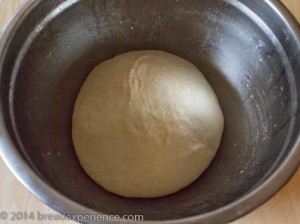 |
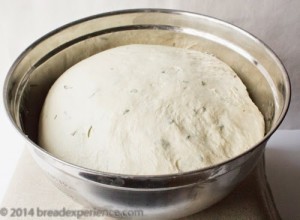 |
Shaping the Rolls/Loaf
Remove the dough from the bowl to a lightly floured surface. Cut off a 1 1/2 pound piece for the boule; then divide the rest into 4 equal pieces. Shape each piece into a round ball.
Work with one piece at a time and cover the remaining pieces to keep them from drying out. Divide each of the remaining 4 pieces into 8 equal pieces using a bench knife and form 32 rolls.
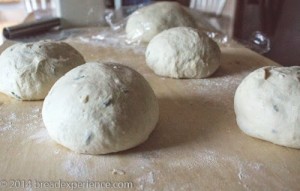 |
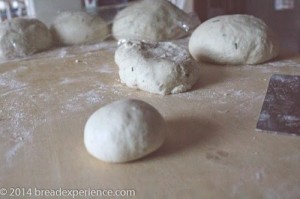 |
Line two or more baking sheets with parchment paper and sprinkle with cornmeal or semolina. Place the rolls on the baking sheets and make sure they are separated so they will not touch even after they rise.
Shape the remaining (1 1/2 pounds) of dough into a tight boule and place it in a floured, lined proofing basket or on another parchment-lined baking sheet. Or, if you prefer shape additional rolls.
Mist the rolls and loaf with spray oil and cover loosely with plastic wrap or a kitchen towel. Proof at room temperature for 1 to 2 hours, or until they double in size.
Baking the Rolls/Loaf
Preheat the oven to 400 degrees with the oven rack on the middle shelf. Remove the plastic wrap and lightly brush the rolls (and the loaf) with olive oil.
Place one pan of rolls in the oven and bake for 10 minutes, then rotate the pan 180 degrees for even baking. Bake them for 10 minutes longer until they are a rich golden brown color. Bake the other pan of loaves.
Bake the loaf for 20 minutes, then rotate and bake for an additional 15 to 20 minutes longer. The loaf should sound hollow when thumped on the bottom.
If the rolls or the loaf has browned completely, but appear to be too soft, turn the oven off and let them bake an additional 5 to 10 minutes longer to firm up.
Remove from the oven and let them cool on a wire rack before serving.
I brushed the rolls with olive oil again after I removed them from the oven. This gave them a beautiful golden sheen.
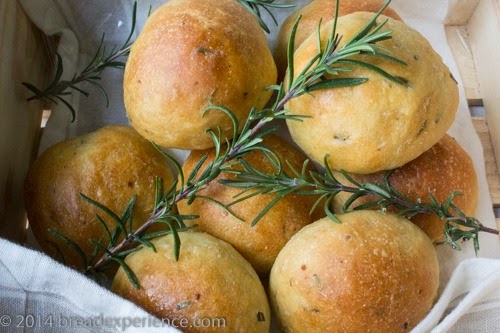
I’m happy to say that these rolls were so popular they didn’t come home with me; however, I still had the loaf at home and was able to enjoy it during the week. Turns out, it makes great cinnamon toast and cheese toast and whatever else you might think of.
Happy Baking!
Cathy
sparecake.com says
Just checking – how much yeast should there be in the biga stage?
I like the sound of this bread!
Cathy W. says
Thanks for catching that. It’s supposed to be 1/2 teaspoon of yeast (not salt) in the biga. I have edited the list of ingredients to reflect this. I do hope you enjoy it.
Happy Baking!
Cathy
Tuscan Muse says
Yum!